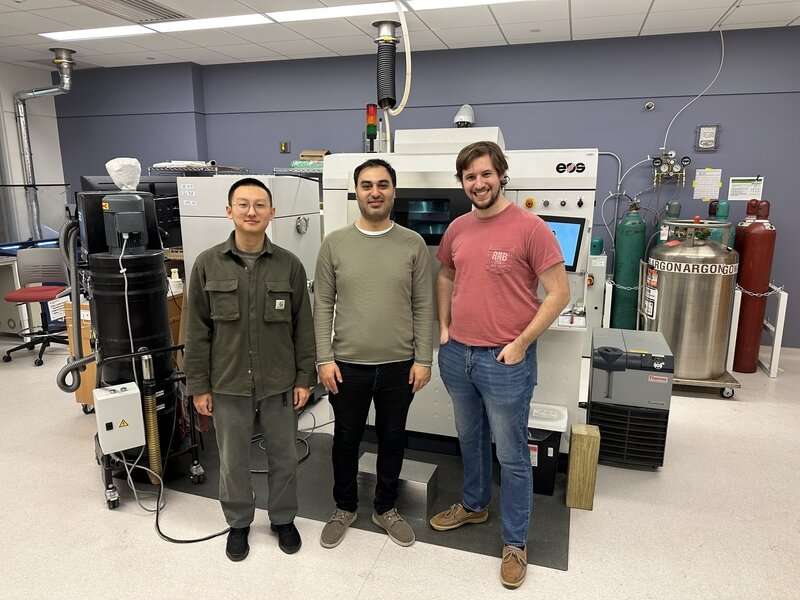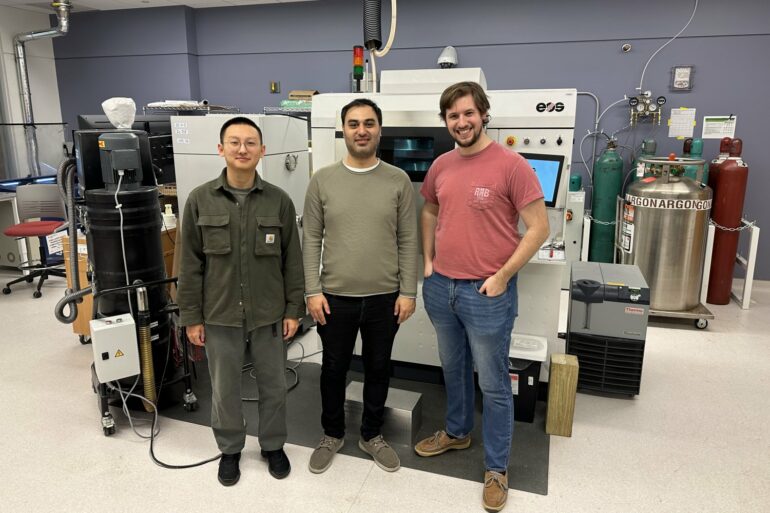The materials key to many important applications in aerospace and energy generation must be able to withstand extreme conditions such as high temperatures and tensile stresses without failing. Now a team of MIT-led engineers reports a simple, inexpensive way to strengthen one of the key materials used today in such applications.
Further, the team believes that their general approach, which involves the 3D printing of a metallic powder strengthened with ceramic nanowires, could be used to improve many other materials. “There is always a significant need for the development of more capable materials for extreme environments. We believe that this method has great potential for other materials in the future,” says Ju Li, the Battelle Energy Alliance Professor in Nuclear Engineering and a professor in MIT’s Department of Materials Science and Engineering (DMSE).
Li, who is also affiliated with the Materials Research Laboratory (MRL), is one of three corresponding authors of a paper on the work that appeared in the April 5 issue of Additive Manufacturing. The other corresponding authors are Professor Wen Chen of the University of Massachusetts at Amherst and Professor A. John Hart of the MIT Department of Mechanical Engineering.
Toward better performance
The team’s approach begins with Inconel 718, a popular “superalloy,” or metal capable of withstanding extreme conditions such as temperatures of 700°C (about 1,300°F). They mill commercial Inconel 718 powders with a small amount of ceramic nanowires, resulting in “the homogeneous decoration of nano-ceramics on the surfaces of Inconel particles,” the team writes.
The resulting powder is then used to create parts via laser powder bed fusion, a form of 3D printing. That process involves printing thin layers of powder that are each exposed to a laser that moves across the powder, melting it in a specific pattern. Then another layer of powder is spread on top, and the process repeats with the laser moving to melt the pattern for the new layer and bond it with the layer below. The overall process can produce complicated 3D parts.
The researchers found that parts made this way with their new powder have significantly less porosity and fewer cracks than parts made of Inconel 718 alone. And that, in turn, leads to significantly stronger parts that also have a number of other advantages. For example, they are more ductile—or stretchable—and have much better resistance to radiation and high-temperature loading.
Plus, the process itself is not expensive because “it works with existing 3D printing machines. Just use our powder and you get much better performance,” says Li.
Xu Song, an assistant professor at the Chinese University of Hong Kong who was not involved in the work, comments, “In this paper, the authors propose a new method for printing metal matrix composites of Inconel 718 reinforced by [ceramic] nanowires. The in-situ dissolution of the ceramic that is induced by the laser melting process has enhanced the thermal resistance and strength of Inconel 718. Moreover, the in-situ reinforcements reduced the grain size and got rid of flaws. Future 3D printing of metal alloys, including modification for high-reflectivity copper and fracture suppression for superalloys, can clearly benefit from this technique.”

Co-first authors of a paper on the work are (from left to right): Jian Liu of the University of Massachusetts at Amherst, and Emre Tekoğlu and Alexander O’Brien, both of MIT.
A huge new space
Li says the work “could open a huge new space for alloy design” because the cooling rate of ultrathin 3D-printed layers of metal alloys is much faster than the rate for bulk parts created using conventional melt-solidification processes. As a result, “many of the rules on chemical composition that apply to bulk casting don’t seem to apply to this kind of 3D printing. So we have a much bigger composition space to explore for the base metal with ceramic additions.”
Emre Tekoğlu, one of the lead authors of the Additive Manufacturing paper, says, “This composition was one of the first ones we decided on, so it was very exciting to get these results in real life. There is still a vast exploration space. We will keep exploring new Inconel composite formulations to end up with materials that could withstand more extreme environments.”
Alexander O’Brien, another lead author, says, “The precision and scalability that comes with 3D printing has opened up a world of new possibilities for materials design. Our results here are an exciting early step in a process that will surely have a major impact on design for nuclear, aerospace, and all energy generation in the future.”
More information:
Emre Tekoğlu et al, Strengthening additively manufactured Inconel 718 through in-situ formation of nanocarbides and silicides, Additive Manufacturing (2023). DOI: 10.1016/j.addma.2023.103478
Provided by
Massachusetts Institute of Technology
This story is republished courtesy of MIT News (web.mit.edu/newsoffice/), a popular site that covers news about MIT research, innovation and teaching.
Citation:
Team uses 3D printing to strengthen a key material in aerospace, energy-generation applications (2023, May 22)



